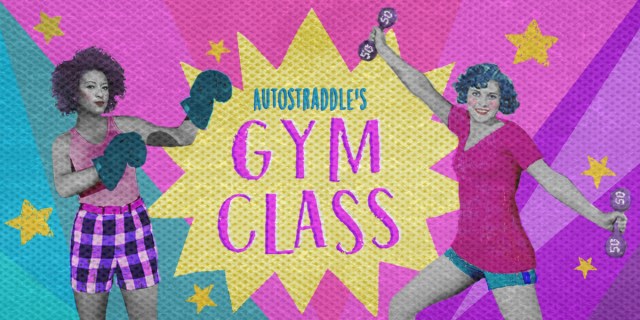
When the weather outside is frightful, it’s the perfect time to work out indoors! If you’ve always wanted to try a commercial gym, or have a membership and don’t know where to begin—well, come on in to Gym Class and let’s get you started! Most fitness centers have a similar setup, with a variety of cardio equipment, weights machines, and free weights. Some facilities will also offer things like studio space (for yoga and other guided classes), spinning bikes, saunas, and hot tubs. I’ll give you the tips you need to get a well-rounded workout at a basic facility. If you can also relax in a hot tub after, that’s awesome—enjoy.
Things You’ll Need
- A gym membership (or trial pass, to see if you like the place)
- Workout clothes: choose something you’re comfortable in that allows you freedom of movement
- A journal to log your workouts and progress
Basic Technique
The most important piece of workout equipment is your journal. If you take a few minutes at home and write down your workout for the day (or your workouts for the whole week), it gives you a firm plan to follow at the gym. Just walk in, start your warmup, and then follow your plan. This will help you to not feel overwhelmed by a busy room with many options. Also—especially as you’re just starting out—it’s important to track your work so you can watch your progress and consistently push to challenge yourself with higher weights, more reps, and so on. Later in this piece I provide a sample template for one week of workouts. Use it as a building block to start creating a fitness plan that incorporates your favorite activities and feels best for you.

Here are the components of a well-rounded session at the gym. You can expect a typical session to take about 45 minutes, including your warmup. If you’d like to add cardio to your routine, I suggest doing so at the end of your workout.
Warmup
Begin your workout with a 5- to 10-minute warmup. This can be on whatever cardio machine you like (treadmill, elliptical, rower, stationary bike, etc.). Keep your effort low: you’re just waking up your muscles and getting your heart rate going a little. For example, a comfortable walking pace for me on the treadmill is 3 mph; for a warmup, I’d walk at that pace with no incline for 10 minutes.
Exercises
When planning your workout, think about your exercises in terms of large muscle groups. I categorize the primary groups as:
- arms
- chest
- back
- core
- legs
You can choose to focus on one group per workout (example: leg day, with several leg- and glute-focused exercises; arms/chest day; core day), or you can structure your workouts to include one or two exercises for each group. In this Gym Class, the sample workouts will be of the one-of-each variety. I like this structure for beginners because it helps you get comfortable with moving around the different areas of the gym, and it also won’t get you so sore in one muscle group that you can’t go in for your next workout. (Sometimes it can be hard to walk after a heavy leg day.)
Sets and Reps
Doing an exercise multiple times is called doing “reps” (repetitions). You do reps in “sets.” A good place to start for most of the exercises here is three sets of 10 reps. This number is easily adjusted (maybe you want to do eight reps per set, or four sets per exercise), but 8-12 is a good target range for reps: if you can’t do eight reps in a row, the weight you’re using is probably too heavy; conversely, if you can easily do more than 12 reps in a row, the weight is probably too light.
Where to Start and Measuring Progress
When you first try an exercise, you’ll need to figure out an appropriate starting weight for your body. Let’s use single-arm dumbbell shoulder-to-overhead press as an example. In this exercise, you start with a dumbbell at your shoulder, press your arm straight up overhead to full extension, then return the dumbbell to your shoulder. That’s one rep. To figure out where you should start, have a variety of dumbbell weights nearby. Try a few reps with 5lbs. If that’s super easy, try a few with 8lbs. Still super easy? Move to 10lbs. Maybe that starts to feel more challenging. Can you do an unbroken set of 10 reps with 10lbs? If not, drop back to 8lbs. In this way, settle on a weight you can do for three sets of 10 reps. Make note of the weight in your journal, and the next time you try the exercise, see if you can do a bit more. Maybe you do two sets at 8lbs, and your third set at 10lbs, and start working toward all three sets at 10lbs that way. You want to do a little more each workout, whether that’s increasing weight or adding another rep or two to your sets.
Machines Versus Free Weights
There are pros and cons to all the equipment in a gym. The weight machines can help you maintain correct form and better target specific muscle groups, but they don’t work the stabilizer muscles or allow full range of motion in the way dumbbells or barbells do. On the flip side, it can be easier to injure yourself with free weights if you’re not using proper form. But please don’t be scared of the free weights! Dumbbells provide a great workout, and I absolutely recommend including them in your routine. If you’re also interested in using the barbell, check out my Gym Class on powerlifting for tips on including the bar in your workouts. Finally, bodyweight work—pushups, lunges, bodyweight squats, and so on—does not require equipment but should be considered an important part of your fitness routine.
Cardio (optional)
If you’d like to include cardio in your gym visit, try a 20- to 45-minute session at the end of your weights session. Aim for maintaining 60-70% of your maximum effort for the full session: this is called steady-state cardio, and it’s beneficial for building up endurance and aerobic fitness. Note: While adding cardio may help you burn fat more quickly, be aware that it may also impede muscle growth. Keep your fitness goals in mind while planning your workouts: if your goal is to add strength and muscle mass, you may want to avoid frequent, sustained cardio sessions.
Stretching (optional)
At the end of your workout, it can be relaxing to find a floor mat and give some love to sore spots. Don’t lie down while your heart rate is still high; take a few minutes to walk around, catch your breath, and ease into your stretching/cool-down time.

Training & Sample Workouts
Here’s a sample week of workouts. Take rest days between workout days; these allow your muscles to repair and recover, which is important part of the strength-building process. I’ve linked to descriptions or videos of each exercise, or to pictures of each machine to help you find it in the gym. If you’re not sure which machine to use, ask a staff member to help you find the correct one for the listed exercise. (Note: 3 x 10 means three sets of 10 reps.)
Monday
Arms: 3 x 10 side dumbbell lateral raises
Chest: 3 x 10 chest butterfly machine
Back: 3 x 10 lat pull-down machine
Legs: 3 x 10 bodyweight squats
Core: 3 x 10 Russian ab twists (advanced: hold a medicine ball or plate to add weight)
Wednesday
Arms: 3 x 10 side dumbbell bicep curls
Chest: 3 x 10 push-ups (modification: keep your knees on the ground, or use a raised surface like a bench)
Back: 3 x 10 seated row machine
Legs: 3 x 10/side bodyweight lunges (advanced: hold dumbbells at your sides)
Core: 3 x 30-second planks
Friday
Arms: 3 x 10 dumbbell overhead press
Chest: 3 x 10 dumbbell bench press
Back: 3 x 10/side dumbbell rows
Legs: 3 x 10 leg press machine
Core: 3 x 10/side bicycle crunches
These workouts are just a small sample of what you can do with bodyweight, dumbbells, and weight machines. When planning your weekly workouts, mix and match as you like to keep things interesting. If you’re not sure which exercises target which muscle groups, look online for ideas. Or spend some time wandering around the weight machine area at your gym: most machines have stickers on them showing which muscles they target, so you can start mentally organizing machines in groups (glutes, chest, back, etc.) and more easily slot them into your workout plan.

Good-to-Know Tips
- Try a different piece of cardio equipment for your warmup each day or week, so you get used to using all of them.
- If available, use your gym’s free training session to help you get acclimated (but be aware it can come with a sales pitch for paid training sessions).
- Ask for assistance when trying new machines—even experienced gym-goers need to be shown how to use new equipment.
- Safety first! Don’t push so hard you can’t go back for your next workout, and if you feel pain during a workout, stop and check in with your body.
- Eat plenty of protein and complex carbs to fuel your workouts and aid muscle growth and recovery.
You’ve Got This!
Have a great time exploring your gym, and let me know if you have questions. I’m happy to give advice on workout plans. Also, I’d love to hear about your progress if you begin a training program. Let’s get stronger together!







